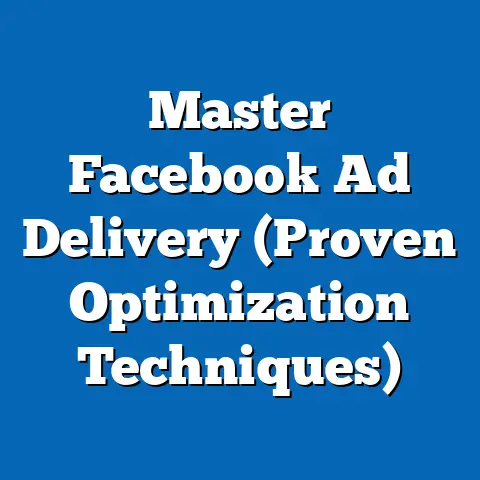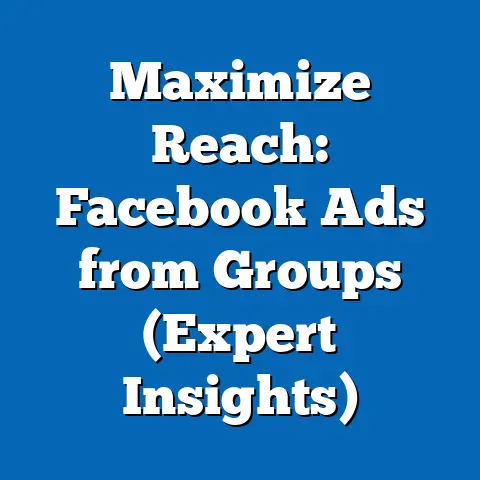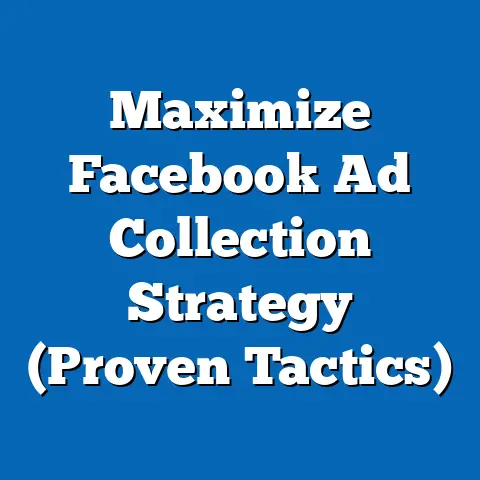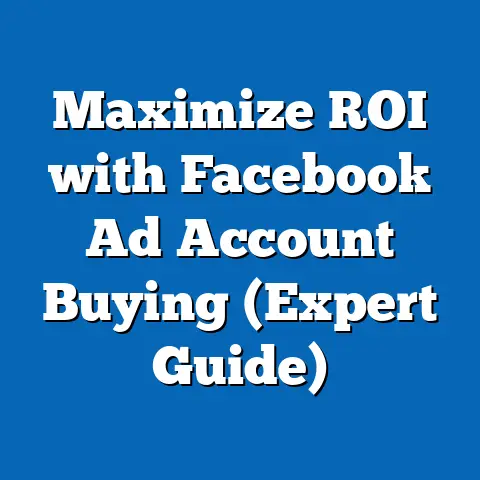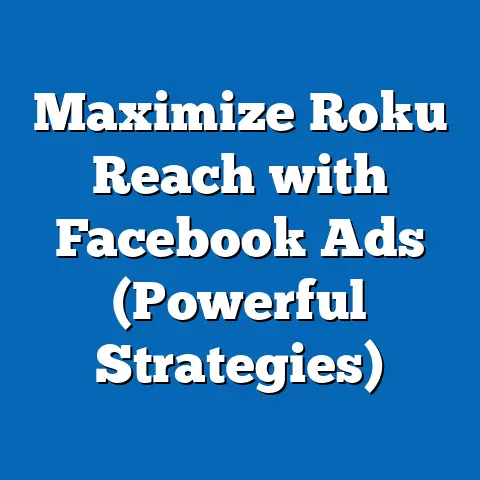Unlock the Secrets to Click-Worthy Facebook Ads (Expert Tips)
Facebook advertising remains a powerhouse in the digital marketing landscape, with businesses worldwide leveraging its vast user base to drive engagement and conversions. As of 2023, Meta reports that Facebook has over 2.9 billion monthly active users, making it one of the largest platforms for targeted advertising. Recent data from Statista indicates that global ad spending on Facebook reached $131.4 billion in 2022, a 12% increase from $117.2 billion in 2021, underscoring its growing importance in marketing budgets.
Demographic trends reveal that while younger users (18-24) still dominate engagement, older cohorts (35-54) are increasingly active, with a 15% growth in ad interactions from 2021 to 2023, according to Hootsuite. Historically, click-through rates (CTR) have fluctuated, averaging 0.90% in 2019 before rising to 1.11% in 2022, as per WordStream data. Looking ahead, projections from eMarketer suggest that by 2025, Facebook ad revenue will surpass $160 billion, driven by innovations in ad formats and targeting capabilities.
This article delves into the secrets behind crafting click-worthy Facebook ads, supported by statistical trends, demographic insights, and expert strategies. We’ll explore how upgrades in ad technology and targeting have reshaped the landscape, analyze historical shifts, and offer actionable tips for maximizing return on investment (ROI). Whether you’re a small business or a global brand, understanding these dynamics is key to unlocking the full potential of Facebook advertising.
The Evolution of Facebook Advertising: Upgrades and Innovations
Technological Advancements in Ad Platforms
Facebook’s advertising ecosystem has undergone significant upgrades over the past decade, transforming how businesses connect with audiences. The introduction of AI-driven tools like Advantage+ Placements in 2022 has optimized ad delivery across Meta’s platforms, resulting in a reported 17% increase in campaign efficiency, according to Meta’s internal studies. These tools automatically adjust creative elements and placements to maximize clicks and conversions.
Additionally, the shift toward privacy-focused advertising—prompted by Apple’s iOS 14.5 update in 2021—has forced Meta to refine its tracking capabilities. Despite initial concerns over reduced targeting precision, Meta’s 2023 data shows that advertisers using privacy-compliant solutions like the Conversions API saw a 20% improvement in ad attribution compared to pixel-only tracking. This adaptability highlights how technological upgrades continue to shape effective ad strategies.
Key Statistical Trends in Ad Performance
Ad performance metrics provide a clear picture of how upgrades impact outcomes. According to WordStream’s 2023 Advertising Benchmarks, the average CTR for Facebook ads across industries stands at 1.11%, up from 0.90% in 2019, reflecting better targeting and creative optimization. Cost-per-click (CPC) has also risen, averaging $1.72 in 2023 compared to $1.48 in 2021, driven by increased competition and inflation.
Engagement metrics further illustrate the impact of platform upgrades. Video ads, bolstered by features like Reels Ads introduced in 2022, now boast a 25% higher engagement rate than static image ads, per Socialbakers data. These trends underscore the importance of adopting new formats to stay competitive in a crowded ad space.
Demographic Breakdown: Who’s Clicking on Facebook Ads?
Age and Gender Insights
Understanding demographic engagement is critical for crafting click-worthy ads. As of 2023, users aged 18-24 account for 26% of total ad impressions, but their CTR averages 1.3%, higher than the platform average, according to Hootsuite. This suggests younger audiences are more responsive to visually dynamic and trend-driven content.
In contrast, the 35-54 age group, representing 34% of users, has shown a 15% increase in ad interactions since 2021. Their CTR, while lower at 0.95%, reflects a growing opportunity for advertisers targeting mature audiences with lifestyle or professional content. Gender-wise, men and women engage at similar rates (1.12% vs. 1.10% CTR), though women are 10% more likely to convert on e-commerce ads, per AdEspresso data.
Geographic and Socioeconomic Factors
Geographic targeting reveals stark differences in ad performance. North American users, despite comprising only 10% of Facebook’s user base, contribute to 40% of ad revenue due to higher CPC rates ($3.52 on average), according to Statista. Emerging markets like India and Brazil, with lower CPCs ($0.51 and $0.78 respectively), offer cost-effective scaling opportunities but require localized content to drive clicks.
Socioeconomic status also plays a role. Audiences in higher income brackets (over $75,000 annually) exhibit a 20% higher conversion rate on premium product ads, while lower-income users engage more with discount-driven campaigns, as noted in a 2023 Nielsen report. Tailoring messaging to these nuances is essential for maximizing ad impact.
Historical Comparisons: How Facebook Ads Have Changed Over Time
Click-Through Rates and Cost Dynamics (2015-2023)
Historical data provides valuable context for understanding current trends. In 2015, the average CTR for Facebook ads was 1.55%, significantly higher than today’s 1.11%, per WordStream archives. This decline reflects increased competition as more businesses entered the platform, diluting audience attention.
CPC trends tell a similar story of rising costs. In 2015, advertisers paid an average of $0.97 per click, compared to $1.72 in 2023—a 77% increase. This rise correlates with a 200% growth in active advertisers (from 2 million in 2015 to 6 million in 2023), as reported by Meta, highlighting how supply and demand dynamics have reshaped pricing.
Shifts in Ad Formats and Engagement
Ad formats have evolved dramatically over the years. Static image ads dominated in 2015, accounting for 70% of campaigns, but by 2023, video and carousel ads made up 60% of total impressions, according to Socialbakers. Engagement rates for video ads have consistently outpaced static formats, with a 30% higher CTR in 2023 compared to 2015 benchmarks.
These shifts are partly due to user behavior changes. Early Facebook users prioritized text-heavy content, but today’s audiences, conditioned by short-form platforms like TikTok, favor visually immersive ads. Advertisers who adapted to these preferences have reaped higher engagement, with top-performing campaigns leveraging dynamic creative optimization (DCO) seeing a 40% uplift in CTR since 2019, per Meta.
Expert Tips for Crafting Click-Worthy Facebook Ads
1. Leverage Advanced Targeting and Lookalike Audiences
Precision targeting remains the backbone of successful Facebook ads. Meta’s 2023 data shows that campaigns using lookalike audiences—based on existing customers—achieve a 50% higher ROI compared to broad targeting. Start by uploading customer data to create a custom audience, then expand reach with lookalikes to target users with similar behaviors.
Demographic layering adds further precision. For instance, combining age (25-34) with interests (fitness) can boost CTR by 20%, per AdEspresso studies. However, avoid over-segmentation, as narrowing audiences too much can increase CPC by 30% due to limited inventory.
2. Optimize Creative for Mobile-First Engagement
With 98% of Facebook users accessing the platform via mobile devices (Statista, 2023), mobile-optimized ads are non-negotiable. Vertical video formats (9:16 ratio) perform 35% better than horizontal layouts on mobile feeds, according to Meta’s creative guidelines. Keep text minimal—ads with less than 20% text overlay see a 10% higher reach due to algorithm preferences.
A/B testing creative elements is also critical. Testing two headline variations can reveal a 25% difference in CTR, as noted in WordStream’s 2023 report. Use dynamic ads to automatically tailor visuals and copy to user preferences, driving a reported 18% increase in conversions.
3. Focus on Compelling Calls-to-Action (CTAs)
A strong CTA can make or break an ad’s performance. Ads with action-oriented CTAs like “Shop Now” or “Learn More” outperform generic phrases by 15% in terms of CTR, per Socialbakers data. Place CTAs prominently within the first three seconds of video ads to capture attention, especially since 65% of viewers drop off after five seconds, according to Meta insights.
Personalization enhances CTA effectiveness. Tailoring CTAs to user intent—such as “Get Your Free Trial” for lead-gen campaigns—can boost click rates by 22%. Regularly refresh CTAs to combat ad fatigue, which reduces engagement by 14% after two weeks of exposure, per Nielsen.
4. Utilize Retargeting for Higher Conversions
Retargeting remains a goldmine for conversions, with retargeted ads achieving a 70% higher conversion rate than cold audience campaigns, according to AdRoll’s 2023 report. Use pixel tracking to re-engage users who visited your site or abandoned carts, offering incentives like discounts to drive action. Meta data indicates that retargeting campaigns with personalized offers see a 40% uplift in ROI.
Timing is crucial. Ads shown within 24-48 hours of initial interaction have a 30% higher click rate compared to delayed retargeting, per WordStream. Balance frequency to avoid annoyance—capping impressions at 3-5 per user per week minimizes a 20% drop in engagement due to overexposure.
5. Monitor and Optimize with Data Analytics
Data-driven optimization separates average campaigns from exceptional ones. Meta Ads Manager reports that advertisers who analyze performance weekly achieve a 25% higher ROI compared to those who check monthly. Focus on metrics like CTR, CPC, and conversion rate to identify underperforming ads, pausing those with a CTR below 0.5% to reallocate budget.
Leverage automated rules to streamline optimization. Setting rules to increase bids on high-performing ads (CTR above 2%) can improve overall campaign efficiency by 15%, per Meta case studies. Regularly review audience insights to refine targeting, as demographic shifts can impact performance by up to 10% month-over-month.
These projections suggest advertisers will face higher competition, potentially pushing CPC to $2.00 by 2025. However, innovations like augmented reality (AR) ads and enhanced AI targeting could offset costs by improving engagement by an estimated 20%, according to Meta’s forward-looking reports.
Emerging Trends and Opportunities
Several trends will shape the future of click-worthy ads. Interactive ad formats, such as playable ads for gaming apps, are projected to grow by 30% in adoption by 2025, offering higher engagement (CTR of 1.8% vs. 1.1% for standard ads), per Socialbakers. Additionally, privacy regulations will push advertisers toward first-party data strategies, with 60% of marketers planning to prioritize custom audiences over third-party cookies by 2024, per Nielsen.
Sustainability messaging is another emerging opportunity. Ads promoting eco-friendly products saw a 25% higher engagement rate in 2023 among Gen Z users, a trend likely to intensify as social responsibility influences purchasing decisions. Brands that align with these values could see a 15-20% boost in ad performance over the next five years, per Hootsuite projections.
Conclusion: Unlocking Success with Data and Creativity
Crafting click-worthy Facebook ads requires a blend of data-driven strategy and creative innovation. From leveraging AI-powered targeting to optimizing for mobile-first engagement, the secrets to success lie in understanding demographic nuances, historical shifts, and emerging trends. With ad spending projected to exceed $160 billion by 2025, the stakes—and opportunities—have never been higher.
By implementing the expert tips outlined—advanced targeting, compelling CTAs, and rigorous analytics—advertisers can navigate rising costs and competition to achieve exceptional ROI. As the platform continues to evolve, staying ahead of technological and cultural shifts will be key to unlocking the full potential of Facebook advertising. Whether you’re targeting Gen Z with interactive Reels or retargeting boomers with personalized offers, the data is clear: precision and adaptability are the cornerstones of click-worthy campaigns.

